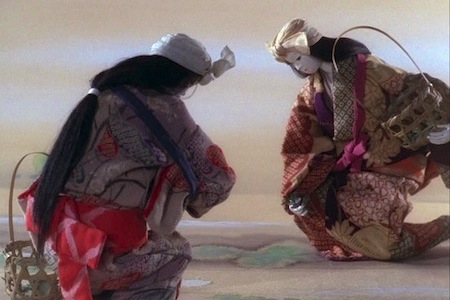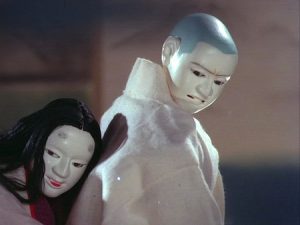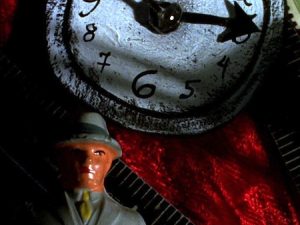
Jiří Trnka, aka “the Walt Disney of Eastern Europe” reportedly worked with Japan’s Kihachiro Kawamoto, who worked in the art department at Toho before developing animating Japanese children’s classics. Whether it’s true or not, one can’t help seeing an association between Kawamoto’s The Demon (1972) and Trnka’s The Hand (1965), though their most literal connection is the prominence of disembodied hands “pulling strings” and we’ve already established the prevalence of that eerie “metaphor.”
Unlike the Czechs, Kawamoto’s culturally attentive stories lack any explicit politics, though The Breaking of Branches is Forbidden (1968) does momentarily critique the religious class, as a haughty monk bungles his guard shift watching a tree when he gets drunk and acts a jerk to some travellers.
The House of Flames (1979) takes a turn into narration, as a traveler learns of the doomed fate of one maiden whose passivity in matters of love left two (less that intelligent) men dead, and made a mess of one “love duck.” A “drama of the absurd,” The House of Flames treats all the dramatic turns with austerity, though one supposes it’s self-evident that a girl who’ll drown herself because her suitors shoot a duck should be absurd (or at least reproductively ineligible).

Dojoji Temple’s watercolor landscapes (1976) are its most haunting asset: These puppets’ gestures appear even more literal against the gauzy, drifty trees and hills behind them. With these puppet films, the more ephemeral, illusive qualities of film are paved over by the hard and fast realities of expressionless objects. It’s as if the puppets are already metaphors and resist any further abstraction or identity. It’s admirable: if only people were so resistant.
An Anthropo-Cynical Farce (1970) features more of Kawamoto’s trademark existential angst but it’s done as a send up of French surrealism. An emcee interrupts a dog race to give the dogs dangling lures and explain to the betting audience that this time, the dogs are betting on them. It’s like a more principled Steve Slater.
Casting puppets in stories of spiritual matters provides an emotional resonance other animations can’t replicate. Book of the Dead (2005) is a story about honor, virtue and lineage and a BOOK of the DEAD. As such this presents another tactile emblem (book) to stand in for a totally ephemeral thing. As with clocks, the allegorical quality is mind f*ck if you start on it. And when nine gods stand in a circle around a tree on a hill, I defy you not to recall the encircling children of M (though shamefully, when a would-be king faced his death and sang “when ducks cry” I thought of Prince).
If this exhumation of the eeriness of puppets has left you unnerved, Janie Geiser may be your antidote. Her appropriation of vintage dolls and figurines reverses the creep factor of Devil Doll by opening a sweetly tattered door to nostalgia. In The Secret Story (1996) Geiser uses old toys, candy molds and zodiac cards to loosely act out the narratives she dreams those toys lived.

In The Red Book (1994), she robs classical feminist text “The Yellow Room” of its theory—her cutouts have a comforting lack of animus but are so charming you identify with them. Her immediate concern with the female body and the suggestion that being in a home forces the female into tailspin (while a man as emotive as an Irish setter looks on) and can’t help but feel like a personal statement, if not just an evocation of Sylvia Plath. And though it came six years before The Quays‘ In Absentia the parallels to what used to be called “hysteria” are palpable, unnerving, sometimes infuriating.
In Lost Motion (1999), the sweetness of her characters’ inner lives emerges but with tragically noir implications. A metal cast businessman in a grey suit finds a note from a woman and goes on a far flung trip via toy trains and outdated maps to find her, the ideal paper doll that’s more projection than reality.
It’s unfair to say we were ever dealing in distinctly “family friendly” materials, but Geiser’s later experiments seem to bring us to the formal opposite of “primitive.” Sure, her images are messy. Geiser’s Ghost Algebra (2009), for example, forces you to ferret out the important noises and images from a too-layered visual landscape, but her underlying issue of animation: forget what’s mobilizing the inanimate—that’s Geiser—what’s breathing life into it? As per her title, the math may not be present, rather, made from our instinct to find answers and the world’s bottomless reservoir of half-interpretable stimulus. Slowly charming intersections begin: a toy horse snaps open, full of red paint. A fifties figurine girl whispers into an anatomically correct ear. A speaker begins its sonic process as leaves jitter with the vibrations.
Whatever it is that animates these objects may be a mystery to preserve in the same ways we preserve other mysteries of faith.
Read Hugo Is a Dummy … Or Is He? Part 1. Read Part 2.



